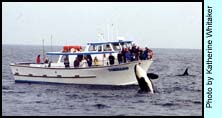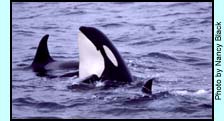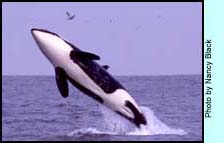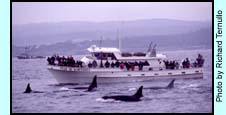|
See ID photos which were
used to identify these Killer Whales. Killer Whales from Puget Sound Observed in Monterey Bay! By Nancy Black  Marine biologists from Monterey Bay Whale Watch documented an incredible
sighting on Saturday, Jan 29, 2000. "Resident" killer whales from Washington
state and British Columbia were sighted in Monterey Bay! The much beloved
K and L pods traveled nearly 1000 miles away from their normal range and
fed on salmon in Monterey Bay. This is an unprecedented sighting according
to biologists who study these whales in Washington and B.C.
Marine biologists from Monterey Bay Whale Watch documented an incredible
sighting on Saturday, Jan 29, 2000. "Resident" killer whales from Washington
state and British Columbia were sighted in Monterey Bay! The much beloved
K and L pods traveled nearly 1000 miles away from their normal range and
fed on salmon in Monterey Bay. This is an unprecedented sighting according
to biologists who study these whales in Washington and B.C.During the summer months these pods inhabit the inland waters of Haro Strait between the San Juan Islands and Vancouver Island, Canada where they feed on runs of salmon. These whales are known by name and number by thousands of people and are the most well known whale population in the world, studied for close to 30 years. All pod members are closely related, and even the adult males remain with their family group for life. Over 50 members comprise these two pods. Ken Balcomb of the Center for Whale Research knows these whales best; he has dedicated his life to the study of these pods. Ken's house overlooks the ocean where these whales pass almost daily during the summer months and his team of researchers volunteer their time during the summer to photo-identify the pods, documenting new individuals, noting missing whales, and following their behavior patterns. They have found some serious problems with these pods, such as increased mortality. In their home waters, the populations of salmon, once abundant, have dwindled due to habitat destruction, damming, and overfishing. In addition these whales carry high toxic loads as they accumulate toxins from their food and some countries still use PCBs that may enter the whale population from fish migrations across the Pacific. They are also the most heavily watched group of whales in the world. No one knows for sure what threatens these whales most, but it might be a combination of many factors.  Robin Baird, a scientist from Canada, was instrumental in getting these
whales listed as threatened in Canada. The United States is considering
listed them as an endangered species. In April 2000, many scientists who
study these whales will meet in Seattle to discuss these issues and determine
measures to save these whales from the increased mortality and low birth
rate that scientists have documented over the last several years.
Robin Baird, a scientist from Canada, was instrumental in getting these
whales listed as threatened in Canada. The United States is considering
listed them as an endangered species. In April 2000, many scientists who
study these whales will meet in Seattle to discuss these issues and determine
measures to save these whales from the increased mortality and low birth
rate that scientists have documented over the last several years.So the question everyone is asking is "Why did the whales travel so far from Washington/B.C. to Monterey Bay, California?" This is still a mystery! During the winter months these whales leave their summer feeding areas in Haro Strait and no one really knows where they go. However, the farthest south they have ever been sighted is Grays Harbor, Washington, on the outer coast. It's possible they are having difficulty finding food off that coast and needed to travel farther for salmon. Killer whale populations are not all the same. In the eastern North Pacific there are three distinct types, "residents", "transients", and "offshores". Each population is genetically distinct, specializes on different prey, exhibits different social and association patterns, has different vocal dialects, and frequents or travels different areas, some overlapping.
 For over thirteen years, Richard Ternullo and I have studied the killer
whales off California. Along with Alisa Schulman-Janiger of Los Angeles
and Mercedes Guerrero of Mexico, we have published a catalog of identified
killer whales. The "transient" type of killer whale is most often sighted
in Monterey Bay; during the spring groups of transients gather in Monterey
Bay to hunt gray whale calves. At other times they may feed on seals,
sea lions, porpoise, and dolphins. "Offshore" killer whales, sometimes
over in groups of 100, are occasionally seen here in winter.
For over thirteen years, Richard Ternullo and I have studied the killer
whales off California. Along with Alisa Schulman-Janiger of Los Angeles
and Mercedes Guerrero of Mexico, we have published a catalog of identified
killer whales. The "transient" type of killer whale is most often sighted
in Monterey Bay; during the spring groups of transients gather in Monterey
Bay to hunt gray whale calves. At other times they may feed on seals,
sea lions, porpoise, and dolphins. "Offshore" killer whales, sometimes
over in groups of 100, are occasionally seen here in winter.On January 29, 2000, Richard, marine naturalist Katherine Whitaker and I were conducting a whale watch aboard the Pt. Sur Clipper, to look at gray whales and search for dolphins. Before we left port, Jerry Wettle aboard the sport fishing boat Reelin sent a report of killer whales in the Bay. Since killer whales are an infrequent sighting and this was apparently a large group, numbering about 40, whale watchers aboard the Pt. Sur Clipper and Star of Monterey departed quickly and raced to the area where the killer whales were reported. We encountered the pod, along with other whale watch boats, just north of Cypress Point (Carmel Bay). As we approached we heard excitement on the VHF radio about breaches, leaps and spyhops by these whales. Once we reached the group we began photo-identifying the pod members. These were whales we did not recognize. However, we have not photographed all the "offshore" killer whales and thought they were part of this larger group. Our boats, along with a team working with us on a film for National Geographic, continued to follow these whales in our 22' research inflatable. After forming a tight group near Carmel Bay, the whales turned back north and headed into the Bay where they spread out over more than two miles while feeding on salmon. We continued to follow the killer whales in our inflatable and watched as they foraged for several hours. By dusk they had crossed the bay, grouped up again and headed northwest near the canyon edge out of the Bay.  After returning to port, we began to wonder about these "unknown whales".
Many whales had open saddles (black intruding into their white saddle
patch behind the dorsal fin), they traveled in a large tight group of
over 50 individuals and they were very active, with lots of breaches and
spyhops. This is uncharacteristic for both California transients and offshore
types. I alerted Alisa Schulman-Janiger, our southern California co-researcher,
to the day's sighting. She also noted that most of the California whales
have closed saddles and opens are a rarity. Along with this, I thought
about the "resident" like behavior we observed and opened a killer whale
catalog from the Pacific Northwest, and found a whale I was sure we had
seen that day. Katherine had her film developed the next morning and we
confirmed 7 whales immediately! We then contacted the people who study
these residents to report our news. Everyone was amazed and couldn't believe
it until they saw our ID photos posted
on the Web. Now, we wonder if they will return and is it possible they
may frequent our area more often in search of food?
After returning to port, we began to wonder about these "unknown whales".
Many whales had open saddles (black intruding into their white saddle
patch behind the dorsal fin), they traveled in a large tight group of
over 50 individuals and they were very active, with lots of breaches and
spyhops. This is uncharacteristic for both California transients and offshore
types. I alerted Alisa Schulman-Janiger, our southern California co-researcher,
to the day's sighting. She also noted that most of the California whales
have closed saddles and opens are a rarity. Along with this, I thought
about the "resident" like behavior we observed and opened a killer whale
catalog from the Pacific Northwest, and found a whale I was sure we had
seen that day. Katherine had her film developed the next morning and we
confirmed 7 whales immediately! We then contacted the people who study
these residents to report our news. Everyone was amazed and couldn't believe
it until they saw our ID photos posted
on the Web. Now, we wonder if they will return and is it possible they
may frequent our area more often in search of food?
Photos by Nancy Black, Richard Ternullo and Katherine Whitaker. Last updated June 6, 2003 |
||||||||||||||||||||||||
